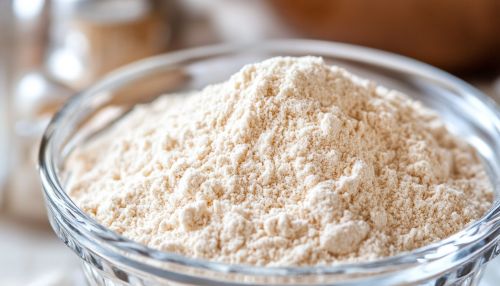Xanthan gum
Introduction
Xanthan gum is a polysaccharide widely used as a food additive and rheology modifier. It is produced by the fermentation of glucose or sucrose by the bacterium Xanthomonas campestris. This biopolymer is notable for its exceptional thickening, stabilizing, and emulsifying properties, making it a versatile ingredient in various industries, including food, pharmaceuticals, and cosmetics.
Chemical Structure and Properties
Xanthan gum is a high molecular weight polysaccharide composed of repeating pentasaccharide units. Each unit consists of two glucose molecules, two mannose molecules, and one glucuronic acid molecule. The primary structure is a cellulose backbone with trisaccharide side chains. The chemical formula can be represented as (C35H49O29)n. The presence of carboxyl groups in the side chains imparts an anionic character to the molecule, which significantly influences its solubility and interaction with other substances.
Xanthan gum is soluble in both hot and cold water, forming highly viscous solutions at low concentrations. It exhibits pseudoplastic behavior, meaning its viscosity decreases with increasing shear rate. This shear-thinning property is particularly useful in applications requiring ease of mixing and pumping.
Production Process
The production of xanthan gum involves several stages, including fermentation, recovery, and purification.
Fermentation
The fermentation process begins with the inoculation of a suitable medium containing a carbon source (glucose or sucrose), nitrogen source, and essential minerals with Xanthomonas campestris. The fermentation is typically carried out in aerobic conditions at a temperature of 28-30°C and pH of 6-7. The bacterium secretes xanthan gum into the surrounding medium as it grows.
Recovery
After fermentation, the broth containing xanthan gum is subjected to heat treatment to kill the bacteria. The xanthan gum is then precipitated by the addition of isopropyl alcohol or ethanol. The precipitate is collected by centrifugation or filtration.
Purification
The crude xanthan gum is washed with alcohol to remove impurities and then dried to obtain a powder. The final product is milled to the desired particle size and packaged for distribution.
Applications
Xanthan gum's unique properties make it suitable for a wide range of applications.
Food Industry
In the food industry, xanthan gum is used as a thickening agent, stabilizer, and emulsifier. It is commonly found in salad dressings, sauces, dairy products, and gluten-free baked goods. Its ability to stabilize emulsions and suspensions prevents the separation of ingredients, ensuring a uniform texture and appearance.
Pharmaceutical Industry
In pharmaceuticals, xanthan gum is used as a binder in tablets, a stabilizer in suspensions, and a controlled-release agent in drug delivery systems. Its biocompatibility and non-toxicity make it an ideal excipient for various formulations.
Cosmetic Industry
In cosmetics, xanthan gum is used to thicken and stabilize lotions, creams, and gels. It enhances the texture and spreadability of products, providing a smooth and consistent application.
Other Applications
Xanthan gum is also used in the oil industry for drilling fluids, in agriculture as a soil conditioner, and in the textile industry for printing pastes.
Health and Safety
Xanthan gum is generally recognized as safe (GRAS) by the FDA and the EFSA. However, excessive consumption can cause digestive issues such as bloating and gas. Individuals with allergies to corn, soy, or wheat should exercise caution, as xanthan gum is often derived from these sources.
Environmental Impact
The production of xanthan gum has a relatively low environmental impact compared to synthetic polymers. The fermentation process is energy-efficient, and the raw materials used are renewable. However, the use of organic solvents in the recovery process poses environmental concerns, necessitating proper waste management practices.
Future Prospects
Research is ongoing to enhance the production efficiency and functional properties of xanthan gum. Genetic engineering of Xanthomonas campestris and optimization of fermentation conditions are areas of active investigation. Additionally, the development of sustainable recovery and purification methods is a priority to minimize environmental impact.


